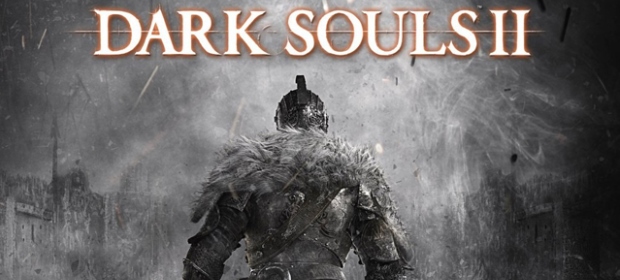The world of Dark Souls II is colossal and utterly lethal. You will not survive by running in blindly and relying on luck or brute force. You must be prepared to play by the rules of Drangleic – which means accepting that every death is a lesson, and every mistake you make is progress.
We’ve been playing it extensively for nearly a month, and have pulled together our 13 top tips for beginners, whether you played the first game or not. Read on for the information that might just keep you alive for the first 12 – 15 hours.
After that, you’re on your own. Good luck with that.
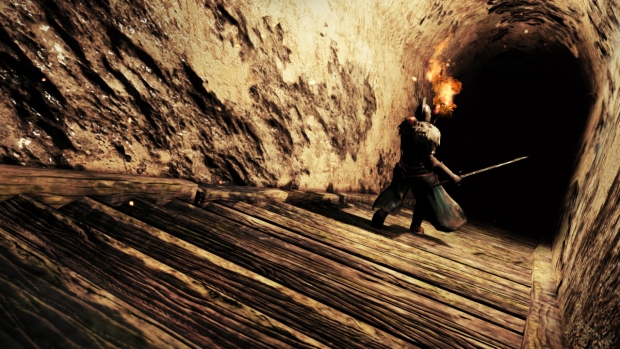
1. CHOOSE YOUR CLASS WISELY
Dark Souls II has a total of eight starting classes, which is several less than the previous game. The upside of this is that each class is more focused. The Warrior and Knight are solid classes for beginners, while the Bandit, Explorer and Swordsman are a little weaker but more specialized. The Cleric is a heavy hitter, and has access to Miracles (predominantly healing magic and buffs that come in incredibly handy), while the Sorcerer is the one slinging Soul Arrows and setting things on fire. Finally, there’s the Deprived, who begins with a loin cloth and some broken equipment.
While the Deprived is the hardest class to start with, its initial level is lower (it starts at Level 6 when everything else starts around Level 12), essentially meaning you’ll earn more points early on to put into the attributes you want to raise. If you’re going for a specialist or personal build and you’re brave enough, the Deprived is the way to go. Either way, it’s important to play to your Class strengths. Don’t pick a Warrior and then try to level Intelligence instead of Strength, or you’ll end up wasting important early levels.
2. EXPLORE THE TUTORIAL AREA
When you first set out into the world with your chosen character, you’ll find yourself in a rocky area full of mist-shrouded doors. Don’t mistake these for boss portals; they’re actually tutorial areas. Even if you’re already clued up, it’s worth exploring this area to find several lootable corpses and to soak up the souls of the easy enemies. Beginners should avoid the large, portly monsters that hang out near the lakeside, but return when you’re stronger and killing them for a reward of 1,000 souls each.
Once you’re out of the shadows and into the settlement of Majula, continue exploring. There are NPCs to speak to, some of whom need favours, as well as a few shopkeepers and a handful of lootable bodies. This immediate area is safe aside a trio of very angry piglets (seriously), so pick it clean.
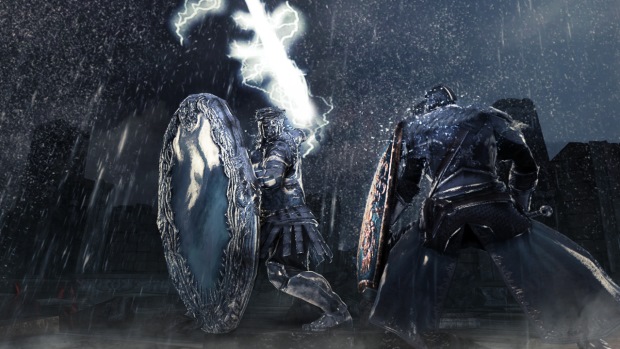
3. PICK THE RIGHT GEAR FOR THE JOB
Early on you’ll meet a crone who sells items and gear, as well as a shiny key that opens the Blacksmith’s shop back in Majula. From then you’re able to use Titanite shards to upgrade your equipment, or buy arrows, bolts and repair powder. You should resist the urge to upgrade right away, and save your shards for when you get a decent weapon or a nice suit of armour.
It’s important to watch your Equip Load. Over-burden yourself and you won’t be able to perform agile combat rolls, swing your sword, raise your shield or run very fast. As with the other games in the series, the onus here is on not taking damage as opposed to simply mitigating it. Heavy armour is less important than a sturdy shield and quick reflexes.
4. KEEP PRESSING ON
This game is supposed to be hard. Even during my first eight hours I repeatedly found my way blocked by a locked door or a tough monster. I almost gave up several times – but there is almost always another way to go at the beginning. Can’t beat a particular boss, head back to Majula and explore, look for another route: a hidden pulley that opens a floodgate underground, maybe a path you strolled right by earlier on and didn’t realise led somewhere. Dark Souls II is initially less open-plan than its predecessor, but there are still several routes to take from the first settlement.
Bonfires are your best friends. They refill your health, allow you to store and retrieve gear, burn certain items for buffs or world-changing effects and, most importantly, facilitate fast travel. There’s no waiting around until you’re halfway through the game before you can teleport – in Dark Souls II you can do it from the off. It makes every new bonfire a great place to scout from, so push through to every one you spot flickering in the distance.
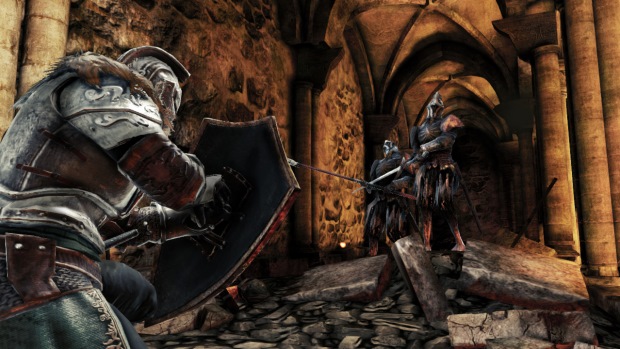
5. USE YOUR SHIELD
You may be a caster or a bowman, or you might like to fight two-handed or dual-wield, but no matter what, a shield is absolutely essential. Stick it in a spare equipment slot (you have three for each hand) and while you’re walking around, keep L1 pressed down so your shield is up. I’ve lost count of the amount of times I’ve been saved from a surprise attack or a sudden arrow, and you’ll be amazed at just how much impact even a simple leather shield can soak up. Running around blindly will get you killed very fast, and so many deaths can be avoided merely by blocking as you head into the unknown.
6. GET A RANGED WEAPON
Likewise, having some kind of ranged weapon in your arsenal is crucial at times. It doesn’t have to be particularly powerful if bows aren’t your bag, but being able to hit an enemy from a distance will save your life more than once. For a start, some monsters like to throw bombs at you from above – or you might come across a group of nasties and need to pull one away from its buddies. There are even a handful of enemies with insane reach.
Bows, throwing knives and bombs are a good way to pull and kite, and you can find fire, poison, or magic ammunition just by exploring and looting. Some enemies also walk away if you back off too far, and shooting them in the face keeps them interested. Also, you should attempt kite tougher enemies to a “safe” spot whenever possible, so that if you do die, it’s easier to retrieve your lost souls unmolested. Seeing that RETRIEVAL sign come up often takes the sting out of the last horrific death you suffered.
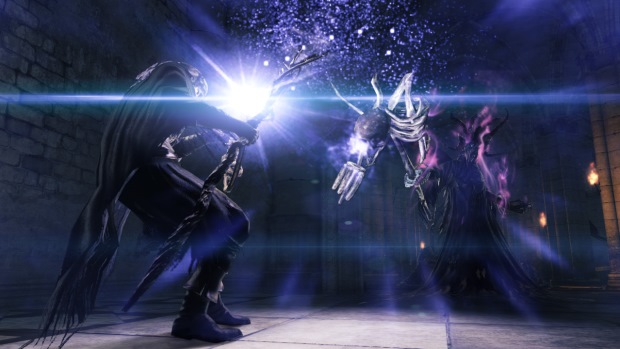
7. LISTEN TO THE GHOSTS OF THE PAST
As with Dark Souls and Demon’s Souls before it, this game features a semi-shared world. Bloodstains on the floor allow you to see how other players met grizzly ends, while burning lettering will translate into a hint or tip left by those who came before. The odd message is someone messing with you – usually advising you to kill an NPC or leap off a cliff – but on the whole the community is a helpful one. You can leave your own tips, too, and the shared world is a great way to team up with other players – or invade their games, of course. Though bear in mind that Dark Souls II will punish griefers by giving other players easier access directly into their version of the game world.
8. ESTUS FLASKS REPLENISH; LIFEGEMS DON’T
You start off with no Estus Flasks and slowly build a up stockpile by bringing shards to the Emerald Herald. As in Dark Souls, these Flasks heal you quickly (despite a terrifying second-long paralysis as you down them) and are refilled at Bonfires, but you don’t have as many as before. Instead they are supplemented by Lifegems, which come in several strengths and can be looted or bought, or chosen as a starting gift for your character. In my experience, it’s best to save the Lifegems – which heal you gradually and can be used while walking – for tougher fights. You can run out of Lifegems and you’ll be left trying to chug a Flask with a boss bearing down on you. Reasonably early on you’ll encounter an old woman selling a finite amount of Lifegems. Talk to her and she will eventually talk about having a bargain for you, next time you meet. She will then move to Majula and have a better stock of Lifegems.
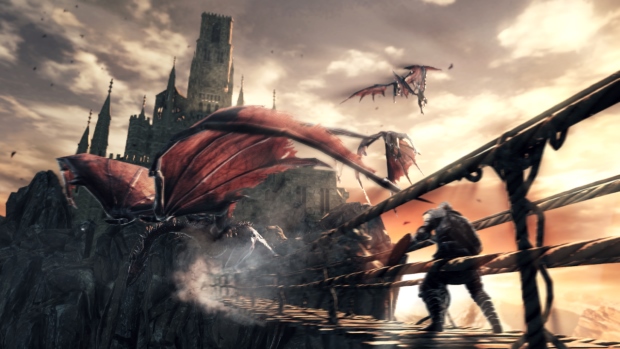
9. DON’T SQUANDER YOUR ASSETS
In-fact, thrifty usage is important for all your consumables. Damage-boosting resins are rare in Dark Souls II, but can mean the edge against a difficult Boss so it’s best not to waste them on vanilla grunts. All the souls you can carry in your inventory should also be saved for when you’re desperate for equipment or curatives and grinding isn’t an option – there’s little point wasting them on levelling up unless you’re really struggling.
The souls of slain bosses often make tempting morsels, but holding onto them can give you access to powerful gear later on in the game. Humanity is replaced by Human Effigies in Dark Souls 2, and these can reverse your Hollowing and restore you to life – however, they are rare, and it’s best not to use one until the negative effects of being Hollow (the permanent decrease in HP, for instance) become untenable.
10. BEWARE: YOU CAN GRIND ENEMIES OUT OF EXISTENCE
Either to make it harder to farm souls or to alleviate the frustration of repeated enemy-strewn runs back to Bosses, From Software have tweaked the respawns system in Dark Souls II. Now, repeated deaths or trips to the Bonfire will see enemy numbers dwindle. The effect is double-edged, as less enemies also means less souls to level up with. An item called a Bonfire Ascetic (which you can choose to start the game with), will reset the enemy presence, but they’ll return tougher – and more rewarding…
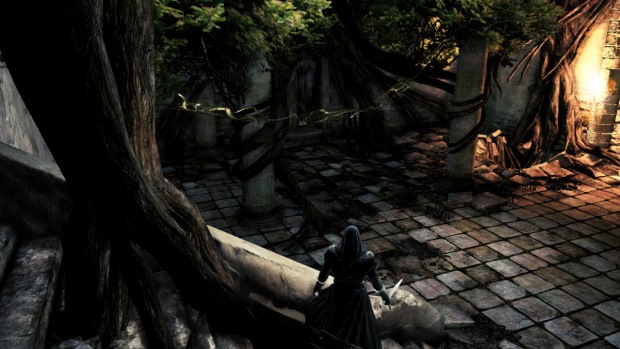
11. HEED THE PEOPLE OF DRANGLEIC
The land of Drangleic is more populated than Lordran, and most of the NPCs you encounter will offer services, advice or aid. It can be tempting to kill some of the whinier ones, and indeed they usually drop a single piece of very desirable loot, but you never know when you’ll need them – and when they’re dead, they stay dead. If someone talks to you, treat them as a friend for the time being. Helping the poor folk of Drangleic is always worthwhile.
12. DO NOT FEAR DEATH
You will die – get used to it. Dark Souls II is less forgiving than the last game, and certainly more punishing of your slip-ups. Repeated deaths not only remove the opportunities for soul farming but can reduce your life down to a maximum of 50%, which is permanent until you reverse your Hollowing. That being said, death should be courted, particularly early on and when you’ve got an empty soul-bank. Don’t be afraid to try that jump, tackle that enemy or open that chest – even if it could be trapped. You should learn from every single death – especially as you’re only dying because you’re making mistakes.
13. TAKE YOUR TIME
This is not a game for rushing through. Haste and complacency will result in your death. Be brave, intrepid even, but always be aware that what lies ahead wants to kill you. There are moments when the best way forward is to take baby steps while peering over your shield. If an enemy is impassable, find a way around. If an area is new, take it in your stride and familiarise yourself with the layout. Dark Souls II has no map of any kind, so you need to commit the gameworld to memory. Look at everything, explore everywhere. Just because you’re dying repeatedly doesn’t mean you shouldn’t be having fun, and the sooner you accept that Dark Souls II requires patience and practice, the happier you’ll be in the world of Drangleic.
Check out our massive Dark Souls II Review here, and take a peak at our Dark Souls II Video Diaries for an insight into the world and mechanics.


